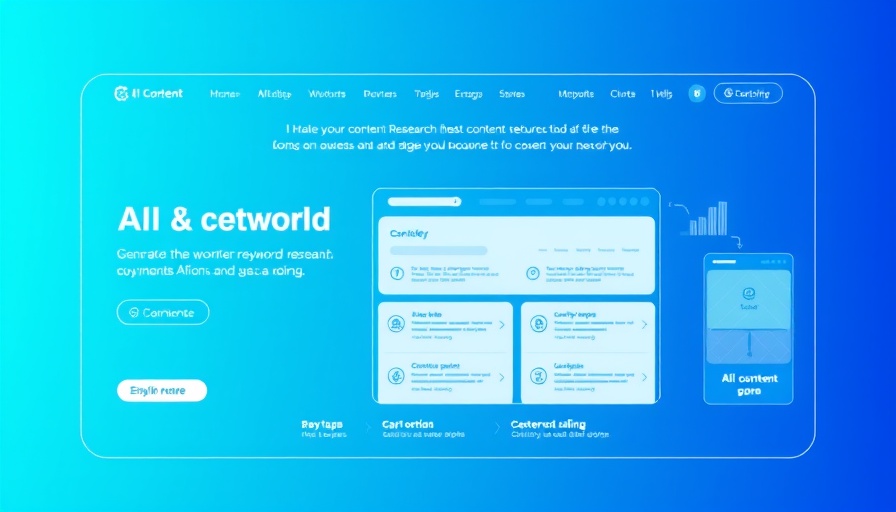
Unlocking the Future of Content Marketing with Generative AI
In today's fast-paced digital landscape, creating consistent, high-quality content can feel like an uphill battle for marketers. They navigate shrinking attention spans, evolving search algorithms, and the influence of generative AI responses that often sidestep traditional search traffic. As content creation tasks pile up—from keyword research to performance tracking—creativity can suffer. Enter Creaitor, a cutting-edge AI-powered content automation platform that aims to ease this burden.
The Evolution of Content Creation: Why Automation Matters
Creaitor is designed to revolutionize content marketing by integrating key features into a single streamlined workflow. With tools for keyword intelligence, brand consistency, and performance analytics, it ensures that marketing teams can produce content faster, while enhancing their strategic focus. In a time when producing engaging content is more crucial than ever, automation can be the secret ingredient to elevate your marketing game.
How Does Creaitor Work? A Closer Look
Creaitor simplifies the content creation process with its powerful set of features:
- Automated Keyword Clusters: Instantly generate relevant keyword groupings to improve search performance.
- Brand Hub: Maintain a consistent brand voice across channels, essential for audience trust.
- Competitor Keyword Analysis: Discover the keywords your competitors are ranking for and seize opportunities to exceed their performance.
- Content Planner: Manage multi-channel campaigns, assign tasks, and keep projects on track with real-time collaboration.
- SEO Scoring: Utilize real-time optimization scores to fine-tune content before it goes live, maximizing its search engine potential.
This integrated approach not only saves valuable time but also maximizes results, allowing marketers to focus on what truly matters: creativity and strategy.
Real Results from Users: The Impact of Creaitor
Tina van Bommel, an SEO Consultant, noted, “Our experience with Creaitor has been nothing short of amazing. The AI tools and SEO suite have revolutionized our content creation process.” Users like Tina report increased productivity—up to 70%—and expansive organic traffic growth, illustrating the effectiveness of AI-driven automation in content marketing.
The Process: How to Get Started with Creaitor
Getting started with Creaitor is straightforward and user-friendly:
- Set Up Your Brand Hub: Define your brand's tone, style, and messaging for consistency.
- Utilize AI-Driven Research: Tap into automated keyword research and clustering to identify opportunities in your market.
- Manage Campaigns Effectively: Leverage the Content Planner to assign tasks and monitor deadlines.
- Create with Confidence: Generate optimized content using built-in SEO recommendations.
- Analyze and Improve: Review results to refine future strategies and maintain growth momentum.
Why Quality Matters: The Shift from Quantity to Strategic Content Creation
With Creaitor, businesses are not just speeding up production; they are ensuring that every piece of content is high-quality and aligned with brand messaging. In a world dominated by information overload, producing valuable content that resonates with the target audience is vital for success.
The Collaboration Advantage: Teamwork in Content Strategy
Creaitor's real-time collaboration features bridge the gap between teams, improving workflow management and ensuring deadlines are met. By fostering a collaborative environment, companies can leverage insights from multiple stakeholders, resulting in richer, more diverse content.
Future Predictions: AI’s Role in Content Marketing
As we look forward, the role of AI in content marketing will continue to expand. Tools like Creaitor exemplify how automation and strategic planning go hand in hand, offering marketers a significant competitive edge. Businesses adopting AI technologies can expect to see improved engagement, elevated brand visibility, and enhanced audience loyalty.
Conclusion: Embrace the Change
In a rapidly evolving digital world, brands must adapt to stay relevant. Creaitor not only empowers marketers to automate their content workflow but also enables them to focus on strategic growth. Businesses must embrace this shift towards automation to harness the power of AI in their marketing efforts.
 Add Row
Add Row  Add
Add 




Write A Comment